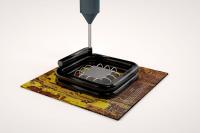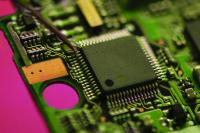Get an up close look at how the dam and fill process works to protect electronic components on a circuit board. This two step method utilizes a damming compound such as Supreme 3HTND-2DM-1 to create a barrier around the component, while the flowable filler material, EP3UF-1, covers the component for protection.
Video Transcript
One of the ways to protect components on a circuit board is by utilizing the dam-and-fill process. Dam-and-filling entails dispensing the damming material around the area to be encapsulated – restricting the flow of the fill from spreading to other parts of the board. The process starts by applying a damming compound, such as Supreme 3HTND-2DM-1, around the component. Supreme 3HTND-2DM-1 is readily dispensed to create a structurally sound barrier. This material will not run and will cure in place in 5-10 minutes at 300°F – in essence forming a dam. After the damming compound has been applied and cured, a filling compound such as EP3UF-1 is dispensed to fill the area inside the dam and cover the component to be protected. EP3UF-1 is a specialized, low viscosity one part system with a filler that has ultra small particle sizes, enabling it to flow even in tiny spaces. This system cures in 10-15 minutes at 300°F and features low shrinkage and high dimensional stability once cured. Both Supreme 3HTND-2DM-1 and EP3UF-1 are thermally conductive, electrically insulating compounds and are available for use in syringes for automated or manual dispensing. Despite being a two step process, dam and fill offers the following advantages over glob topping: flow of the filling compound is controlled and restricted, it can be applied to larger sections of the board and the filling compound flows better than a glob top, allowing better protection underneath and around component. For more information, contact us to discuss your application.
Featured Products
 |
Supreme 3HTND-2DM-1 Toughened epoxy system for bonding, sealing and specialty dam-and-fill encapsulation. Requires no mixing. Rapid heat curing. Passes NASA low outgassing testing. Transfers heat efficiently. Stellar electrical insulation properties. Serviceable from -100°F to +400°F. |
 |
EP3UF-1 One component epoxy for bonding and underfill applications. Thermally conductive/electrically insulative. Meets NASA low outgassing specifications. High mechanical strength properties. Ultra fine particle sizes lowers thermal resistance. Convenient processing at moderate temperatures. Serviceable from -60°F to +250°F. |
